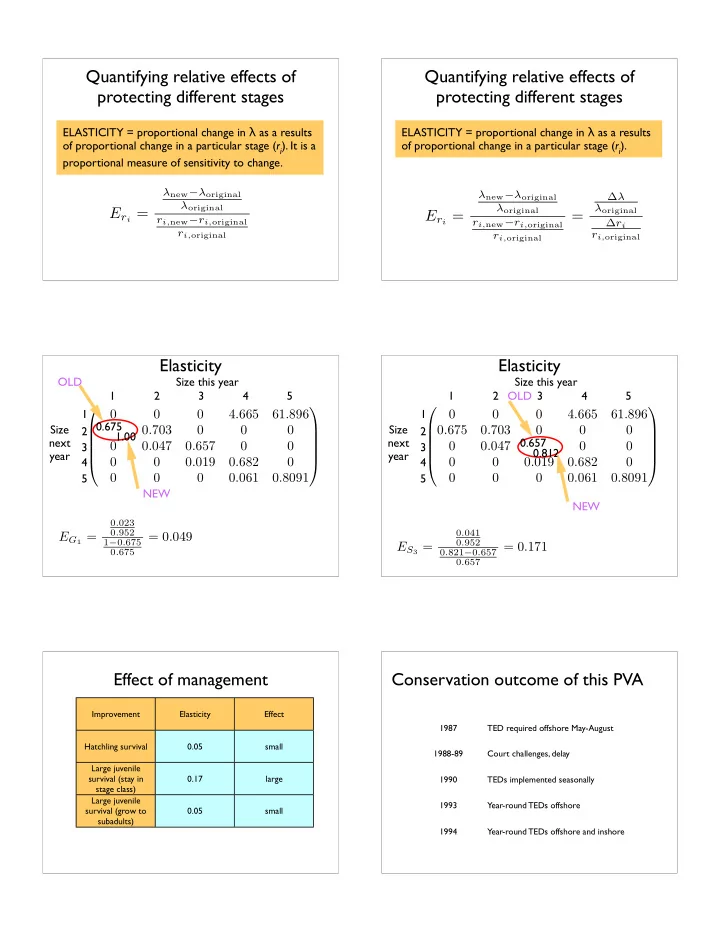

Quantifying relative effects of Quantifying relative effects of protecting different stages protecting different stages ELASTICITY = proportional change in � as a results ELASTICITY = proportional change in � as a results of proportional change in a particular stage ( r i ). It is a of proportional change in a particular stage ( r i ). proportional measure of sensitivity to change. λ new − λ original λ new − λ original ∆ λ λ original λ original λ original E r i = E r i = = r i, new − r i, original ∆ r i r i, new − r i, original r i, original r i, original r i, original Elasticity Elasticity OLD Size this year Size this year 1 2 3 4 5 1 2 OLD 3 4 5 1 1 0 0 0 4 . 665 61 . 896 0 0 0 4 . 665 61 . 896 0.675 Size Size 2 2 0 . 675 0 . 703 0 0 0 0 . 675 0 . 703 0 0 0 1.00 next next 0.657 3 0 0 . 047 0 . 657 0 0 3 0 0 . 047 0 . 657 0 0 0.812 year year 4 4 0 0 0 . 019 0 . 682 0 0 0 0 . 019 0 . 682 0 5 5 0 0 0 0 . 061 0 . 8091 0 0 0 0 . 061 0 . 8091 NEW NEW 0 . 023 0 . 952 0 . 041 E G 1 = = 0 . 049 1 − 0 . 675 0 . 952 E S 3 = = 0 . 171 0 . 675 0 . 821 − 0 . 657 0 . 657 Effect of management Conservation outcome of this PVA Improvement Elasticity Effect 1987 TED required offshore May-August Hatchling survival 0.05 small 1988-89 Court challenges, delay Large juvenile survival (stay in 0.17 large 1990 TEDs implemented seasonally stage class) Large juvenile 1993 Year-round TEDs offshore survival (grow to 0.05 small subadults) 1994 Year-round TEDs offshore and inshore
Assumptions of structured PVA Density dependent survival (as discussed) All individuals in a stage class are the same No density dependence � does not change Only one population Density and growth rate Density dependent fecundity Number of N t = λ N t − 1 individuals Time Density and Growth Density and Growth Density with independent discrete growth Density with independent discrete growth N t = λ N t − 1 N t = λ N t − 1 Independent continuous growth Independent continuous growth dN dN dt = rN dt = rN Density-dependent continuous growth dN dt = rN (1 − N K )
Carrying capacity K Density and carrying capacity Carrying capacity K Carrying capacity K is the maximum stable 100 population size 80 60 Population dN dt = rN (1 − N size 40 K ) 20 20 40 60 80 100 Time Assumptions and remedies for Invasive species PVAs Basics Predicting invasions Managing invasions Individuals are not the same !" use structured model No density dependence !" add density dependence � never change !" add stochasticity to model Only one population !" use meta-population model Stochasticity will add variability, for example environmental variability induces changes in vital rates Invasive species How big is the problem? Second largest cause of extinction: Basics 4500 exotic species in the USA (exotic=non-native) How big is the problem? [OTA 1993] Definitions More than 25% of all plants in Florida are non-native How do invasives move/spread? Effects of invasives Predicting invasions Managing invasions
A few exotics in Florida Hydrilla ( Hydrilla verticillata ), from Sri Lanka Water hyacinth (Eichhornia crassipes) Australian paperbark tree ( Melaleuca quinqueneria ) Brazilian pepper (S hinus terebinthifolius ) Chinese tallow (Sapium sebiferum) Hydrilla Water hyacinth Brazilian pepper tree Chinese tallow Paper bark tree
Definitions How invasives move/spread Stow-aways Introduced (exotic) species = a species living outside its native range Invasive species = introduced species with dramatically expanding populations
How invasives move/spread Stow-aways Commerce/Curiosity
Gypsy moth Rana ridibunda (lake frogs) were accidentally introduced at several places in Switzerland and France Specialty food Academic education introduced 1868/1869 How invasives move/spread Excerpts from a website about the Smoky Mountains National Park: The wild hog, Sus scrofa, is native to Stow-aways Europe, Asia, Northern Africa, Japan, and Commerce/Curiosity the Malayan Islands. In 1912, a shipment of European wild boar from Poland or Recreation Germany was transported to a private game preserve on Hoopers Bald in western North Carolina. Hoopers Bald is only 15 miles southwest of the park boundary in what is now the Nantahala National Forest. European Starling How invasives move/spread Stow-aways Commerce/Curiosity Recreation Aesthetics The European starling was first introduced to the United States in New York City, in 1890. Inspired by William Shakespeare's plays, Eugene Scheffland let loose one hundred starlings in Central Park.
Recommend
More recommend